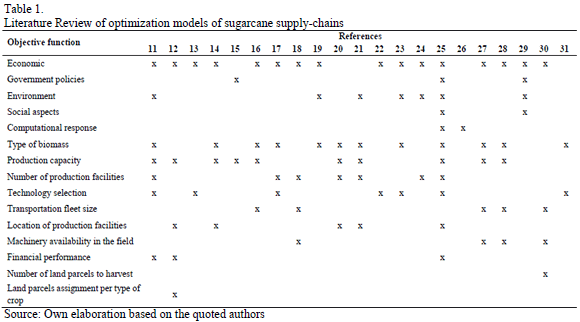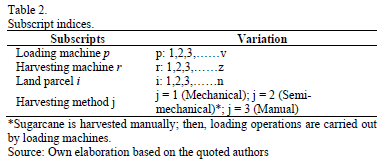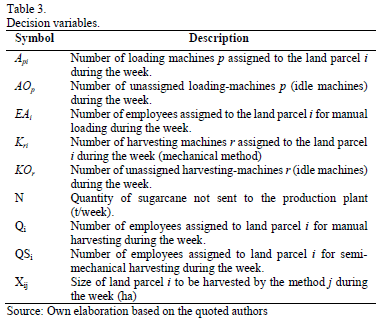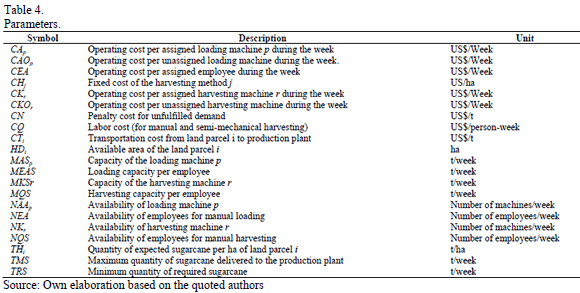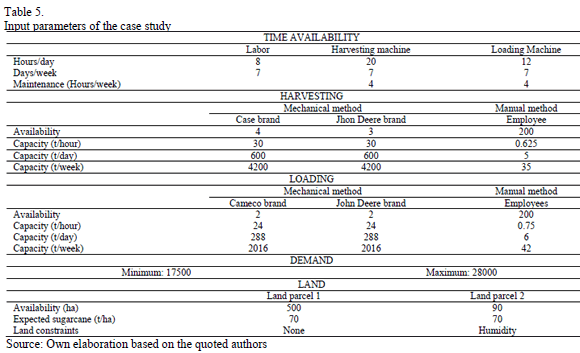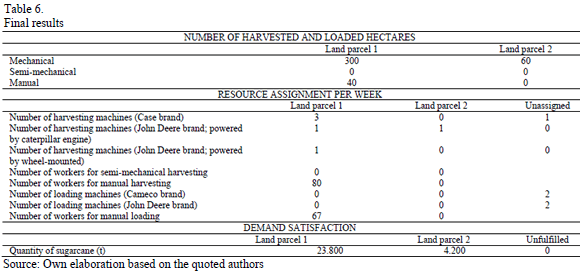Serviços Personalizados
Journal
Artigo
Indicadores
-
 Citado por SciELO
Citado por SciELO -
 Acessos
Acessos
Links relacionados
-
 Citado por Google
Citado por Google -
 Similares em
SciELO
Similares em
SciELO -
 Similares em Google
Similares em Google
Compartilhar
DYNA
versão impressa ISSN 0012-7353
Dyna rev.fac.nac.minas vol.83 no.195 Medellín jan./fev. 2016
https://doi.org/10.15446/dyna.v83n195.49490
DOI: http://dx.doi.org/10.15446/dyna.v83n195.49490
A mixed-integer linear programming model for harvesting, loading and transporting sugarcane. A case study in Peru
Modelo de programación lineal entera mixta para el corte, carga y transporte de caña de azúcar. Un caso de estudio en Perú
Marcela María Morales-Chávez a, José A. Soto-Mejía b & William Sarache c
a Programa de Ingeniería Comercial, Universidad Libre Seccional Pereira, Pereira, Colombia. mmorales@unilibrepereira.edu.co
b Facultad de Ingeniería Industrial, Universidad Tecnológica de Pereira, Pereira, Colombia. jomejia@utp.edu.co
c Facultad de Ingeniería y Arquitectura, Universidad Nacional de Colombia, Manizales, Colombia. wasarachec@unal.edu.co
Received: March 4th, de 2015. Received in revised form: August 12th, 2015. Accepted: August 28th, 2015
This work is licensed under a Creative Commons Attribution-NonCommercial-NoDerivatives 4.0 International License.

Abstract
Due to opportunities for economic and social development in the biofuels market, improvement to the supply chain has become a relevant matter. In agro-industrial supply chains, procurement costs are highly relevant. Since sugarcane is a high performance raw material for ethanol production, this paper proposes a Mixed-Integer Linear Programming Model for cost optimization for harvesting, loading and transportation operations. The model determines the quantity of machines and workers to meet the biofuel plant requirements. Costs of resources for harvesting and loading as well as transportation costs from the land parcel to the production plant are minimized. Also, the model calculates the cost of penalties for shortages (unmet demand) and the cost of equipment idle time. The implementation of the model in a Peruvian biofuels company, showed a cost reduction of around 11 % when compared to the current costs.
Keywords: mixed-integer lineal programming; supply chain planning; sugarcane; biofuels.
Resumen
Debido a las oportunidades de desarrollo económico y social del mercado de los biocombustibles, el mejoramiento de su cadena de suministro se ha convertido en un tema altamente relevante. Dado que la caña de azúcar es una de las materias primas de mayor rendimiento para la producción de etanol, el presente artículo propone un modelo de Programación Lineal Entera Mixta para optimizar los costos en las operaciones de corte, cargue y transporte. El modelo determina la cantidad de máquinas y trabajadores para satisfacer los requerimientos de la planta de biocombustible. Se minimizan los costos de asignación de equipos, costos de transporte y adicionalmente se consideran los costos de penalización por demanda no satisfecha y por ociosidad de los equipos disponibles. La aplicación de este modelo en una empresa Peruana, presentó un porcentaje promedio de disminución de costos del 11 % al ser comparados con los costos actuales de la empresa.
Palabras clave: programación lineal entera mixta; planeación de cadenas de abastecimiento; caña de azúcar; biocombustibles.
1. Introduction
Biofuel supply chains have been identified as a strategic sector for Latin America [1]. Some countries are stimulating biofuel production to reduce fossil fuel dependency and, in this way, guarantee their energy security at lower prices [2-4]. Although several investigations on biofuel production have focused on identifying a more efficient feedstock, sugarcane is considered to be a high yield biomass in the production process [5].
In Peru, biofuel production is considered to be one of the seven most important sectors [6]; therefore, ethanol production from sugarcane is highly relevant for economic growth projections. The supply chain is made up of a group of companies involved in the flow of materials, information and capital, starting with the unprocessed raw materials and finishing with the end consumer [7-9]. Fig. 1 shows the general structure of the biofuel supply chain from sugarcane.
Bearing in mind that between 47% and 58% of ethanol production costs depend on the sugarcane crop [10], this stage becomes an important target to reduce costs in the entire supply chain. Some operations related to harvesting and loading cane are relevant. Also, given the complex nature of agro-industrial processes [9], it is important to consider the penalties derived from unmet demand and idle machines. In addition, harvesting, loading and transporting sugarcane are operations commonly affected by several constraints, such as land conditions, grinding requirements, availability and resource capacity (machinery and manpower) and production scheduling. Therefore, identifying the optimal resource allocation to reduce costs without affecting delivery goals is a decision of great complexity and economic relevance in supply chain planning.
In this sense, this paper shows a Mixed-Integer Linear Programming Model (MILP), for operations planning for the harvesting, loading and transportation of sugarcane to supply a biofuel production plant. The model takes into account optimization of four types of costs: allocation of machinery and workforce, transportation from the farm to the biofuel production plant, penalties for unfulfilled orders and idle machinery. Also, in the case of the mechanical harvesting method, land conditions for machinery selection are considered. The model was implemented in a case study in Peru, resulting in a cost reduction of around 11 % when compared to the current costs.
In order to explain the model, this paper has been structured as follows: First, a literature review is presented in Section 2. Several papers that discuss the improvement of a biofuel supply chain in the upstream stage are examined. Second, in Section 3, the structure of the proposed optimization model is explained in two phases: in the first, the general procedure is described by identifying its purpose, as well as the resources and costs that must be taken into account; in the second, the structure and some details of the mathematical model are explained. Third, in Section 4, a case study is solved using a well-known computational tool. Finally, in Section 5, the conclusions and some suggestions for future model applications are outlined.
2. Literature review
Biofuel supply chain improvement has been a matter of great interest in recent years. A systematic literature review was carried out using the ISI - Web of Science and SCOPUS databases. The search was confined to identifying papers that were concerned with the specific objective of the research presented in this paper. About 43 papers associated with the selected key words were found; however only 21 of these were considered to be relevant. According to the results, an important increase in contributions on this topic, especially over the last five years (73.9%), was detected. Most of these studies have been carried out in the United States (28%), Italy (12%), France and Cuba (8%). Papers on this subject in relation to Peru were not found. Table 1 summarizes a brief comparison of the 21 analyzed papers based on the scope of the objective function and the set of decision variables.
According to Table 1, the focus of a significant part of the studies is on supply chain design that included biomass type, technology selection, capacity allocation and the facilities required for the production stage. In other words, few contributions on supply chain planning were found. Regarding the first echelon of the supply chain (upstream), few studies examined the characteristics of the typical logistics operations for sugarcane, such as harvesting, loading and transportation from the land parcel to the production plant. It is important to emphasize that 91.3% of the articles examine operations where the crop is an input parameter, which reinforces the originality of this article where land parcel selection for sugarcane cultivation is a decision variable.
Additionally, the economic criterion is the most common objective function defined for sugarcane supply-chain optimization, although some of the articles take into account economic factors and environmental impact simultaneously. From the economic point of view, 21.41% of the studies aim to maximize expected net revenues and the rest are focused on cost minimization, emphasizing transportation, harvesting and warehousing operations. Likewise, only two researchers addressed opportunity cost analysis taking into account sugarcane maturity and crop investment.
Finally, models considering cost of equipment downtimes and cost of penalties for unmet demand were not identified in the literature review. Models focused on resource allocation (machinery and labor) to land parcels based on terrain constraints were not detected.
3. Structure of the model
The purpose of the mathematical model is to select the quantity of hectares to be collected per land parcel. It also allows for the selection of the type of harvesting method from three alternatives: mechanical, semi-mechanical and manual. In addition, the model selects the type of equipment for harvesting and loading operations, as well as the workforce required for a semi-mechanical or manual method. Table 2 shows the subscript indices used in the model; in turn, Tables 3 and 4 summarize the decision variables and the parameters respectively.
3.1. Objective function
The cost parameters in the objective function were grouped as follows:
- Machinery costs (harvesting and loading machines). This includes the operation costs and the cost of equipment idle time. The latter is obtained based on the fixed cost of unassigned machinery.
- Workforce costs for cut and loading operations.
- Costs related to harvesting method. This includes maintenance personnel costs, staff and other inputs.
- Penalty costs for unfulfilled demand. This cost is agreed in the supply contract.
- Transportation costs.
The main purpose of the model is the minimization of the total costs, which is determined by:
Min (Costs) = Operation cost per harvesting method + Transportation cost for sugarcane delivered from each land parcel to the production plant + Penalty cost for unfulfilled demand + Cost per assigned harvesting machine + Cost per idle harvesting machine + Cost per assigned loading machine + Cost per idle loading machines + Cost of assigned workforce for manual harvesting + Cost of assigned workforce for manual loading.
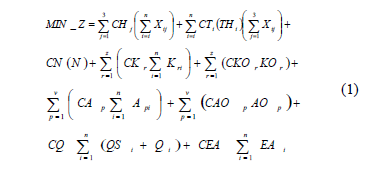
3.1. Model constraints
Model constraints are represented by equations 2 to 14. The set of constraints includes land availability, production plant demand, equipment capacity, workforce availability and land conditions.
The system of equations is as follows:
Land:
Available area per land parcel (ha)

Demand:
- Minimum amount of sugarcane required (t/week)

- Maximum amount of sugarcane to be sent to the production plant (t/week)

Equipment availability:
- Harvesting machines availability (quantity/week)

- Loading machines availability (quantity/week)

Workforce availability:
- Workers' availability for harvesting (quantity/week): workers are divided into two groups; first one of them takes part in the semi-mechanical method; the second one is assigned to the manual method.

- Workers' availability for manual loading (quantity/week)

Equipment capacity:
The equal symbol in the capacity constraints is required to achieve maximum equipment exploitation when assigned to every land parcel (uptime - maintenance time). The uptime for loading machines depends on the maximum time that sugarcane can wait to be processed after being cut without affecting its yield.
- Harvesting machines capacity per land parcel (t/week)

- Loading machines capacity per land parcel (t/week)

Workforce capacity:
There are two groups of workers for harvesting operations: group 1 is assigned to semi-mechanical harvesting and group 2 is assigned to manual harvesting. The constraints are:
- Workers' capacity for semi-mechanical harvesting in every land parcel (t/week)

- Workers' capacity for manual harvesting in every land parcel (t/week)

- Workers' capacity for manual loading in every land parcel (t/week)

Land conditions:
The proper operation of harvesting machines (powered by a caterpillar engine or wheel-mounted) depends on the land parcel characteristics; for example, wheel-mounted machines encounter difficulties when assigned to wetlands. Therefore, depending on the foreman assessment of each type of land, the following constraint will come in to play:
- Harvesting machines t unassigned to the land parcel i due to land conditions.

Non- negativity condition and integer variables:
All variables are constrained to values greater than or equal to zero. Furthermore, the following variables are constrained to integer values.

4. Case study
This model was implemented in a Peruvian ethanol production company. The supply chain was comprised of sugarcane harvesting and loading operations, raw material transportation, the ethanol production process and finally, transportation to the international market. Although the company had several land parcels planted with sugarcane, the model was applied to support the operations programming of harvesting, loading and transportation for only two of these. This decision was made because, when the study was conducted, the generated raw material (41,300 t) exceeded the ethanol plant requirement (28,000 t). However, the model can be adjusted insofar as ethanol demand increases. Table 5 shows the input parameters given by the company; however, information about costs was omitted due to confidentiality agreements with the company.
By using GAMS (General Algebraic Modeling System) professional software, the model was solved. The model was run on a microcomputer provided with 1.66 GHz Intel processor and 4.6 GB of memory RAM. The problem was solved efficiently since the computational time was of a thousandth of second.
According to the results, 300 ha of land parcel 1 should be harvested using the mechanical method, assigning five machines for this operation (three Case brand, one John Deere brand powered by caterpillar engine and one John Deere brand powered by wheel-mounted). This outcome highlights another advantage of the proposed model, which allows for programming of different types of machines for this operation. Also, 40 ha of land parcel 1 must be processed using the manual method, which implies the assignment of 147 workers to harvesting and loading operations. Regarding land parcel 2, the model chose the mechanical method to collect 60 ha; however, due to terrain conditions, the harvesting machine powered by the caterpillar engine was assigned instead of the wheel-mounted machine. Based on this resource allocation, 28,000 tons of sugarcane (23,800 from land parcel 1 and 4,200 from land parcel 2) can be processed, satisfying 100% of the ethanol plant requirements.
Although the model penalizes equipment idle time, the semi-mechanical method was not included in the final solution, even though four loading machines and one harvesting machine are unnecessary. This decision shows the existing overcapacity in the agricultural echelon of the supply chain. As a consequence, the company must increase its marketing efforts. From another point of view, the company can take advantage of idle machines to implement preventive maintenance activities. The obtained total cost was approximately 11% less than the current costs, showing significant savings for the company. Table 6 summarizes the obtained solution.
5. Conclusions
Biofuel supply chain improvement has been a matter of great interest in recent years. Although the literature review shows an important number of papers on this topic, most of them are aimed at supporting decisions regarding supply chain design. The analysis showed that a significant part of the studies oriented to supply chain design, considered the biomass type, technology selection, capacity allocation and facilities as the most important decision variables; however few papers on optimization models for supply chain planning were found, specifically those oriented toward analyses of the particularities of the first echelon (upstream) of the sugarcane supply chain.
For instance, few studies examined the characteristics of the typical logistics operations for sugarcane, such as harvesting, loading and transportation from the land parcel to the production plant. Also, models that took into account the cost of equipment downtime and the cost of penalties for unmet demand were not identified in the literature review. Models oriented to resource allocation (machinery and labor) to the land parcels based on the terrain constraints were not detected.
In contrast, the proposed model shows several advantages that can be summarized as follows: 1) it analyzes operations programming related to harvesting, loading and transporting sugarcane, using land parcel selection as a decision variable; 2) the model considers the optimization of four types of costs: allocation of machinery and workforce, transportation from the farm to the biofuel production plant, penalties for unmet orders and idle machinery; 3) in the case of the mechanical harvesting method, terrain constraints for machinery selection were taken into account.
According to the results obtained in the case study, the current cost of the company was reduced by approximately 11%. By analyzing three alternatives for harvesting and loading operations (mechanical, semi-mechanical and manual), 300 ha with the mechanical method and 96 ha with the manual method were assigned. Because the model did not take into account the use of the semi-mechanical alternative, four loading machines and one harvesting machine were not used affecting the idle time cost. In general, the model established the required resources to support the operations programming in the first echelon of the supply chain; thus, the results show the number of machines, work force and staff necessary to meet the raw material requirements of the production plant.
Due to the level of complexity of the present model in relation to the number of land parcels analyzed, computer time was not a problem; nevertheless the effect on the set of variables and constraints must be checked for a greater amount of land parcels. The model shows some disadvantages that suggest some future research lines. For example, it is necessary to analyze other features related to operations such as internal transportation, yield for several sugarcane varieties and other soil constraints. Other variables such as demand uncertainty and multi-period and environmental conditions could be analyzed in order to provide a better tool to support decision-making.
Acknowledgments
The authors wish to thank the Universidad Tecnológica de Pereira for its academic and financial support through the research project assigned code number 1110-622-38514 (Colciencias).
References
[1] Pareja, P.C., Sevilla, S. y Coello, J., Estudio sobre la situación de los biocombustibles en el Perú, Lima, [Online] 2008, 68 P. Available at: http://www.cedecap.org.pe/uploads/biblioteca/48bib_arch.pdf [ Links ]
[2] Franco, C.J., Flórez, A.M. y Ochoa, M.C., Análisis de la cadena de suministro de biocombustibles en Colombia. Revista de Dinámica de Sistemas, 4(2), pp. 109-133, 2008. [ Links ]
[3] Duarte, A., Sarache, W.A.and Cardona, C., Cost analysis of the location of Colombian biofuels plants. DYNA, 79(176), pp. 71-80, 2012. [ Links ]
[4] Cortés-Marín, E., Suarez-Mahecha, H. and Pardo-Carrasco, S., Biocombustibles y autosuficiencia energética. DYNA, [Online] 76(158), pp. 101-110. 2009 Available at: http://www.scopus.com/inward/record.url?eid=2-s2.0-75249097474&partnerID=tZOtx3y1 [ Links ]
[5] Moncada, J., El-Halwagi, M.M. and Cardona, C.A., Techno-economic analysis for a sugarcane biorefinery: Colombian case. Bioresource Technology, 135, pp. 533-543, 2013. DOI: 10.1016/j.biortech.2012.08.137. [ Links ]
[6] Ministerio de Educación del Perú. Plan nacional estratégico de ciencia, tecnología e innovación para la competitividad y el desarrollo humano PNCTI 2006-2021, Lima, [Online]. 2014. Available at: http://www.minedu.gob.pe/normatividad/reglamentos/PlanNacionalCTI-CDH2006-2021.php. [ Links ]
[7] Council of Supply Chain Management Professionals. Supply Chain Management, [Online]. 2013. Available at: https://cscmp.org/about-us/supply-chain-management-definitions. [ Links ]
[8] Sarache, W.A., Costa, Y. and Martinez, J., Environmental performance evaluation under a green supply chain approach. DYNA, 82(189), pp. 207-215, 2015. DOI: 10.15446/dyna.v82n189.48550. [ Links ]
[9] Duarte, A., Sarache, W.A. and Costa, Y., A facility-location model for biofuel plants: Applications in the Colombian context. Energy, 72, pp. 476-483, 2014. DOI: 10.1016/j.energy.2014.05.069. [ Links ]
[10] Consejo Nacional de Política Económica y Social. Conpes 3510. Lineamientos de política para promover la producción sostenible de biocombustibles en Colombia, Bogotá,[Online]. 2008, 44 P. Available at: http://www.minminas.gov.co/minminas/downloads/UserFiles/File/Conpes3510.pdf [ Links ]
[11] Marvin, W.A., Schmidt, L.D., Benjaafar, S., Tiffany, D.G. and Daoutidis, P., Economic optimization of a lignocellulosic biomass-to-ethanol supply chain. Chemical Engineering Science, 67(1), pp. 68-79, 2012. DOI: 10.1016/j.ces.2011.05.055 [ Links ]
[12] Giarola, S., Bezzo, F. and Shah, N., A risk management approach to the economic and environmental strategic design of ethanol supply chains. Biomass and Bioenergy, 58, pp. 31-51, 2013. DOI: 10.1016/j.biombioe.2013.08.005 [ Links ]
[13] Osmani, A. and Zhang, J., Stochastic optimization of a multi-feedstock lignocellulosic-based bioethanol supply chain under multiple uncertainties. Energy, 59, pp. 157-172, 2013. DOI: 10.1016/j.energy.2013.07.043 [ Links ]
[14] Ortiz-Gutierrez, R.A., Giarola, S. and Bezzo, F., Optimal design of ethanol supply chains considering carbon trading effects and multiple technologies for side-product exploitation. Environmental Technology, 34(13-14,SI), pp. 2189-2199, 2013. DOI: 10.1080/09593330.2013.829111 [ Links ]
[15] Sparks, G.D., Ortmann, G.F. and Lagrange, L., An economic evaluation of soybean-based biodiesel production on commercial farms in Kwazulu-natal, South Africa. Agrekon, 50(3), pp. 68-89, 2011. DOI: 10.1080/03031853.2011.617862 [ Links ]
[16] Shastri, Y., Hansen, A., Rodríguez, L. and Ting, K.C., Development and application of biofeed model for optimization of herbaceous biomass feedstock production. Biomass and Bioenergy, 35(7), pp. 2961-2974, 2011. DOI: 10.1016/j.biombioe.2011.03.035 [ Links ]
[17] Giarola, S., Patel, M. and Shah, N., Biomass supply chain optimisation for Organosolv-based biorefineries. Bioresource Technology, 159, pp. 387-396. 2014. DOI: 10.1016/j.biortech.2014.02.109 [ Links ]
[18] Lin, T., Rodríguez, L.F., Shastri, Y.N., Hansen, A.C. and Ting, K.C., Integrated strategic and tactical biomass-biofuel supply chain optimization. Bioresource Technology, 156, pp. 256-66, 2014. DOI: 10.1016/j.biortech.2013.12.121 [ Links ]
[19] Balaman, Ş.Y. and Selim, H., Multiobjective optimization of biomass to energy supply chains in an uncertain environment. Computer Aided Chemical Engineering, 33, pp. 1267-1272, 2014. DOI: 10.1016/B978-0-444-63455-9.50046-5 [ Links ]
[20] Yoda, K., Furubayashi, T. and Nakata, T., Design of automotive bioethanol supply chain using mixed integer programming. Nihon Enerugi Gakkaishi/Journal of the Japan Institute of Energy, 92(11), pp. 1173-1186, 2013. DOI: 10.3775/jie.92.1173 [ Links ]
[21] Ivanov, B.B., Dimitrova, B. and Dobrudzhaliev, D., Optimal location of biodiesel refineries: The Bulgarian scale. Journal of Chemical Technology and Metallurgy, 48(5), pp. 513-523, 2013. [ Links ]
[22] Ortiz-Gutiérrez, R., Penazzi, S., Bernardi, A.L., Giarola, S. and Bezzo, F., A spatially-explicit approach to the design of ethanol supply chains considering multiple technologies and carbon trading effects. Computer Aided Chemical Engineering, 32, pp. 643-648, 2013. DOI: 10.1016/B978-0-444-63234-0.50108-1 [ Links ]
[23] Čuček, L., Martín, M.J.P., Grossmann, I.E. and Kravanja, Z., Multi-objective optimization of a biorefinery's supply network. AIChE Annual Meeting, Pittsburgh, 2012. [ Links ]
[24] Song, H., Dotzauer, E., Thorin, E., Guziana, B., Huopana, T. and Yan, J., A dynamic model to optimize a regional energy system with waste and crops as energy resources for greenhouse gases mitigation. Energy, 46(1), pp. 522-532, 2012. DOI: 10.1016/j.energy.2012.07.060 [ Links ]
[25] You, F. and Wang, B., Optimal design and operations of cellulosic biofuel supply chains under uncertainty. AIChE Annual Meeting, Minneapolis, 2011. [ Links ]
[26] Shastri, Y.N., Hansen, A.C., Rodríguez, L.F. and Ting, K.C., A novel computational approach to solve complex optimization problems involving multiple stakeholders in biomass feedstock production. American Society of Agricultural and Biological Engineers Annual International Meeting, Pittsburgh, 2010, pp. 542-555. [ Links ]
[27] Shastri, Y.N., Hansen, A.C., Rodríguez, L.F. and Ting, K.C., Biomass feedstock production and provision: A system level optimization approach. AIChE Annual Meeting, Nashville, 2009. [ Links ]
[28] Shastri, Y.N., Domdouzis, K., Hu, M., Hansen, A.C., Rodríguez, L.F. and Ting, K.C., System level analysis of biomass feedstock production for bioenergy sector. American Society of Agricultural and Biological Engineers, Annual International Meeting, Reno, 2009, pp. 2203-2222. [ Links ]
[29] Rozakis, S., Sourie, J. and Vanderpooten, D., Integrated micro-economic modelling and multi-criteria methodology to support public decision-making: The case of liquid bio-fuels in France. Biomass and Bioenergy, 20, pp. 385-398, 2001. DOI: 10.1016/S0961-9534(01)00004-6 [ Links ]
[30] Malik, S.B., Satsangi, P.S., Tripathy, S.C. and Balasubramanian, R., Mathematical model for energy planning of rural India. International Journal of Energy Research, 18(4), 469-482, 1994. [ Links ]
[31] Tripathy, S. C., Satsangi, P. S., Balasubramanian, R. and Malik, S. B. Artificial neural network application to energy system planning. International Journal of Engineering Intelligent Systems for Electrical Engineering and Communications, 7(3), pp. 121-126, 1999. [ Links ]
M.M. Morales-Chávez, received a BSc.an Industrial Engineering in 2006 and the MSc. in Operations Research in 2011 both from the Universidad Tecnologica de Pereira, Colombia; she is currently enrolled in the PhD program in Engineering at Universidad Nacional de Colombia, Sede Manizales, Colombia. From 2006 until today, she has been working as a consultant in several companies. Currently, she is professor in the Comercial Engineering Program, Universidad Libre-Seccional Pereira. Her research interests include: operational research, supply chain optimization, business logistic and operations management. ORCID: 0000-0002-7384-8745
J.A. Soto-Mejía, received a BSc. Sciences in Physics in 1980 and an MSc. in physics in 1982, both from the Kharkov Maximo Gorki University, Russia. In 2002 he received a PhD in Computational Engineering from the Universidade Estadual De Campinas, Brasil. From 1991 he has worked as full professor at Universidad Tecnológica de Pereira, Colombia. His research interests include: operational research, multivariate analysis, simulation and supply chain optimization. ORCID: 0000-0002-0205-6863
W. Sarache, received a BSc. in Industrial Engineering in 1993 from Universidad de Ibagué, Ibagué Colombia; thereafter he received an MSc. in Industrial Engineering in 1998 and a PhD in 2003 both from the Universidad Central de Las Villas, Cuba. From 1992 to 1999 he worked as operations manager in manufacturing companies. From 2000 until today he has been professor at Universidad Nacional de Colombia. His research interests include: operations management, supply chain management and business logistic. ORCID: 0000-0003-3543-4151.














